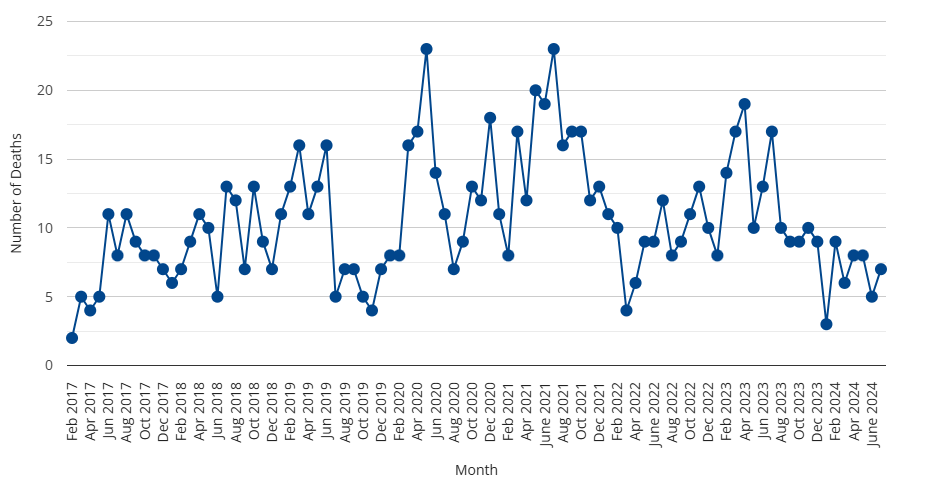Opioid toxicity
We use this information to alert partners and stakeholders and help inform effective responses and service delivery to residents.
We are also working with partners to develop an Opioid Strategy for Peel. The goal is to ensure we are collaborating on initiatives to prevent and reduce harms related to opioid use in the region.
The information reported on this page is updated quarterly.
Opioid toxicity deaths in Peel, 2017 to 2024
Between 2005 and 2013, the number of opioid toxicity deaths per year in Peel remained stable (average: 26 deaths per year).
The number of deaths increased sharply in 2014 (45 deaths) and again in 2017 (81 deaths). This graph shows the increase in 2017 deaths began in June and the number of deaths have remained high through 2018 and 2019. Following the decrease in opioid toxicity deaths between July 2019 and February 2020, deaths increased again starting in March 2020.

Source: Ontario Agency for Health Protection and Promotion (Public Health Ontario). Interactive Opioid Tool. Toronto, ON: King's Printer; 2024. Coroner's Opioid Investigative Aid, January 2020 to January 2024, Office of the Chief Coroner for Ontario, December 13, 2024.
Note: Death data for 2022 and 2023 should be considered preliminary and is subject to change as remaining cases are closed by the Office of the Chief Coroner of Ontario. The data includes both confirmed and probable cases. Probable cases are those for which the investigation to determine cause of death is ongoing. Death data is based on location of incident. If location of incident is incomplete, some records may have been assigned according to location of death.
Type of opioid directly contributing to accidental opioid toxicity deaths, October 2023 to September 2024
Before 2014, the percentage of opioid toxicity deaths in Peel where fentanyl was detected was low (average: 13%). Coinciding with the increase in total opioid toxicity deaths in 2014, the percentage of opioid toxicity deaths where fentanyl was detected also increased sharply to 35% between 2014 and 2016.
Of the most recent opioid toxicity deaths in Peel (October 2023 to September 2024) fentanyl was detected in 63% of deaths. It should also be noted that more than one type of opioid can be detected per death.
| Type of opioid | Peel (number and per cent) Total: 88 | Ontario (number and per cent) Total: 1,125 |
|---|---|---|
| All types of fentanyl combined | 75 (82%) | 1,939 (84%) |
| Fentanyl | 57 (63%) | 1,684 (73%) |
| Methadone | 7 (8%) | 249 (11%) |
| Carfentanil | 4 (4%) | 38 (2%) |
Source: Coroner's Opioid Investigative Aid. October 2023 to September 2024 Office of the Chief Coroner for Ontario, extracted February 28, 2025.
Note: The following substances had five or fewer deaths in Peel – buprenorphine (0), carfentanil, codeine, hydrocodone (0), hydromorphone, morphine, oxycodone, nitazenes (0), oxymorphone (0), tramadol, and UA7700 (0).
Resources related to opioid use data
- Public Health Ontario interactive opioid tool
- Ontario Drug Policy Research Network Ontario prescription opioid tool
- Public Health Agency of Canada apparent opioid toxicity deaths data
Learn about Peel's opioid strategy.